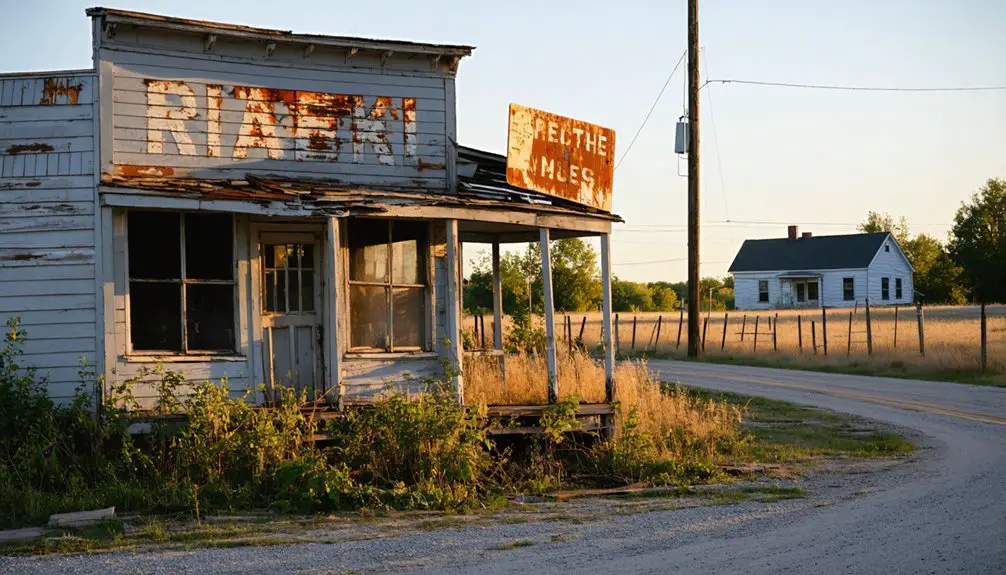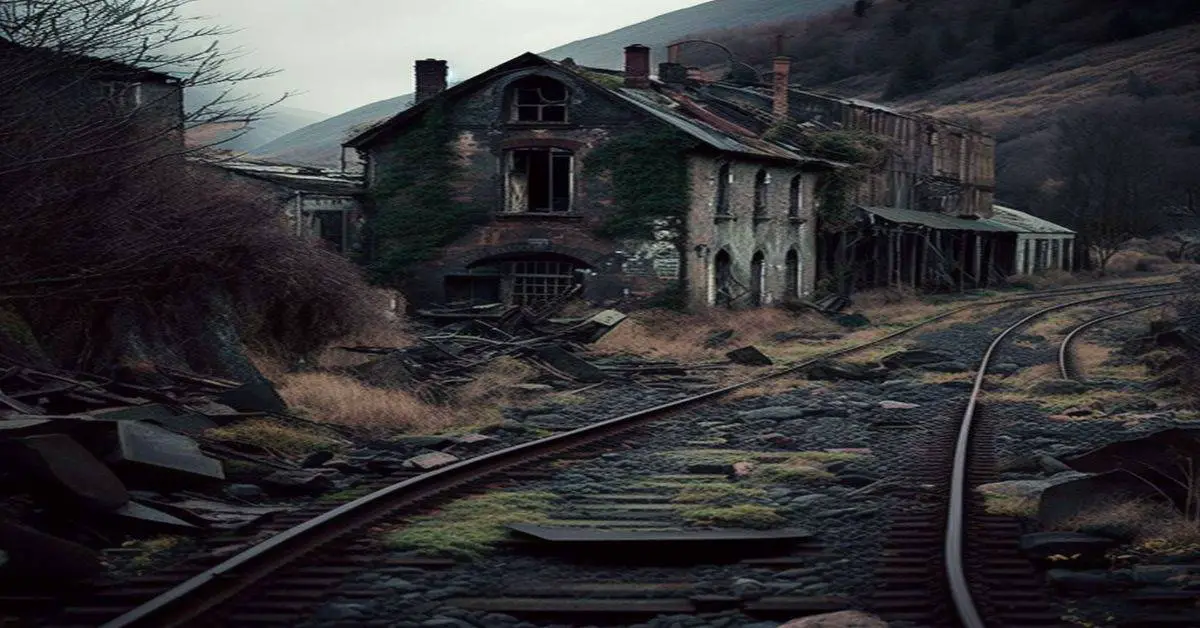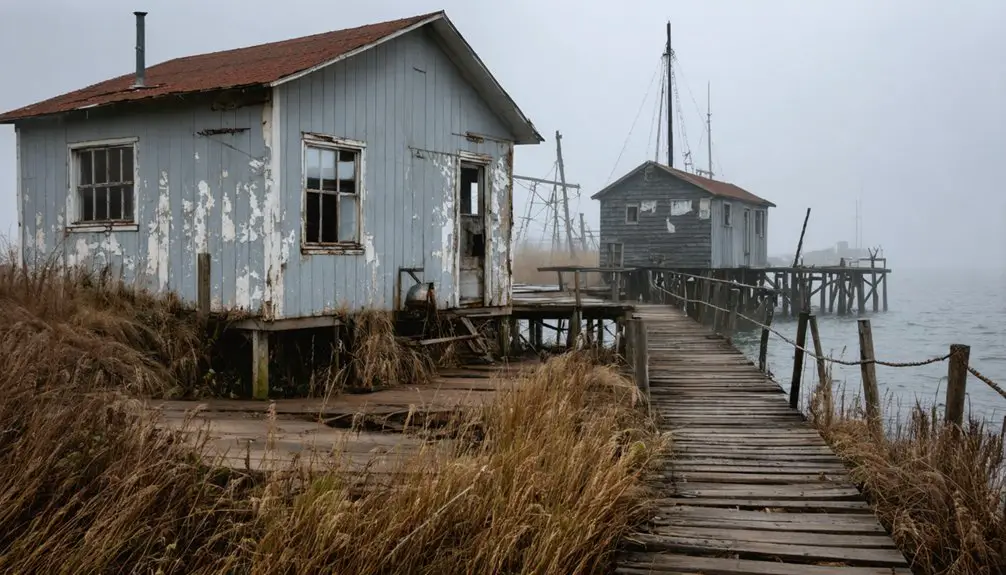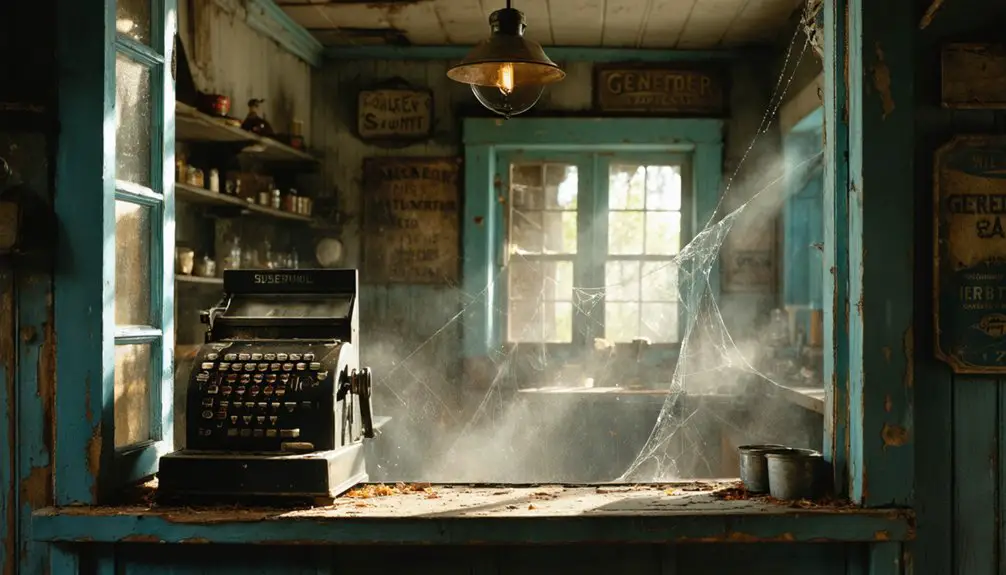You’ll find Staadts 2.5 miles southwest of Stratford in Marathon County’s Eau Pleine town. Once part of Wisconsin’s mining heritage, this ghost town emerged during the region’s mining boom but declined as mineral resources depleted. Today, you can explore its architectural remnants, including concrete silos and stone wells that dot the rolling woodland landscape. The site’s rich history of mining, agriculture, and eventual exodus holds many untold stories within its abandoned structures.
Key Takeaways
- Staadts was established in Marathon County’s Eau Pleine town, located 2.5 miles southwest of Stratford, Wisconsin.
- The town’s decline began with the depletion of mineral resources, leading to widespread exodus of workers and families.
- Architectural remnants, including concrete silos and stone wells, provide evidence of the town’s agricultural and mining heritage.
- The community experienced significant population loss during the 1920s as residents relocated to urban centers for better employment.
- Historical records track Staadts’ development until 1953, with coordinates 44°46′45″N 90°07′12″W preserved by the Wisconsin Historical Society.
Early Settlement and European Roots
While French explorers Louis Jolliet and Father Jacques Marquette’s 1673 discovery of the Mississippi River marked the beginning of European presence in Wisconsin, the region’s rich lead deposits had already drawn Native American miners for generations.
By 1690, French settlers noticed indigenous mining activities throughout southwest Wisconsin, setting the stage for future settlement patterns.
As European powers recognized the strategic value of lead for ammunition production, cultural influences began shaping the region. Fort Crawford’s construction in 1816 helped protect the growing settlements in Prairie du Chien and surrounding areas.
The British fur traders maintained significant economic control in the region despite U.S. territorial claims after the Revolutionary War.
You’ll find that skilled Cornish miners were among the first waves of European immigrants, bringing their mining expertise to boom towns like Mineral Point and Platteville.
They were soon joined by settlers from Norway, Switzerland, and domestic migrants from New York and New England, creating a diverse tapestry of communities that expanded beyond the original mining settlements.
Mining Heritage and Economic Growth
As lead deposits drew prospectors to southwestern Wisconsin in the 1820s, the region experienced its first significant mining boom, with production reaching 13 million pounds of lead annually by 1829. Early settlers commonly built primitive hillside shelters for living quarters during this period.
The decline of lead mining in southern Wisconsin prompted exploration northward, leading to new mineral discoveries and opportunities.
You’ll find that skilled Cornish miners brought advanced mining technology to the area, particularly in Mineral Point, where they’d later establish the region’s largest zinc smelting facility.
Three key factors shaped the area’s economic sustainability:
The region’s economic resilience rested on three pillars: improved transportation, mining diversification, and the rise of agriculture.
- The development of efficient transportation routes, including the 1855 Sault Ste. Marie canal
- The shift from lead to zinc mining as lead deposits depleted
- The evolution of farming as a primary occupation, with mining becoming seasonal work
Daily Life in the Mining Community
In Staadts’ bustling mines, you’d find miners working grueling 10-12 hour shifts underground, where Cornish-introduced ventilation systems offered minimal relief from the constant darkness and dust.
You’d witness tight-knit groups of miners developing strong bonds as they watched out for each other amid daily hazards like cave-ins, flooding, and the ever-present threat of respiratory illness. The community faced similar health concerns to modern times, with silica dust exposure causing widespread breathing problems.
Despite the dangers, these underground relationships formed the backbone of the broader community, as miners carried their workplace camaraderie into town life through shared ethnic traditions and social gatherings. During World War I and II, high zinc demand invigorated the mining community with new jobs and businesses.
Work Routines and Hazards
During the peak mining years of Staadts, Wisconsin, miners endured grueling year-round work schedules that’d begin before dawn and stretch late into evening.
You’d find yourself descending into deep underground tunnels where steam-powered drills had replaced manual methods by the 1870s, marking a significant equipment innovation in mining safety. The miners primarily extracted high-grade iron ore containing up to 70% iron from the rich deposits.
Your daily challenges would’ve included:
- Battling constant flooding threats below the water table, requiring vigilant operation of pumping systems
- Maneuvering poorly ventilated tunnels while handling heavy equipment and extracting ore
- Facing the ever-present risk of cave-ins and tunnel collapses due to unstable rock formations
Even with technological advances, you’d still confront hazardous conditions from poor air quality and equipment accidents, while extreme Wisconsin winters added another layer of danger to your already perilous work. The Upper Mississippi Valley region’s rich mining heritage is now preserved and shared through educational programs at local museums.
Social Bonds Underground
Three pillars formed the social foundation of Staadts’ mining community: shared hardship, ethnic bonds, and mutual support networks.
You’d find these connections ran deepest underground, where miners relied on each other for survival and companionship during long, dangerous shifts.
Above ground, you’d see these bonds strengthen through community gatherings at churches, social halls, and local taverns.
Welsh immigrants established many of these social traditions as they were the first European settlers to mine the region.
Miners preserved their cultural identity through traditional celebrations, music, and storytelling passed down from their homelands.
If tragedy struck, mutual aid societies quickly mobilized to support affected families.
Women played vital roles in maintaining these social networks through church activities and community events, while extended families shared childcare duties.
This web of relationships created a resilient community that helped miners cope with isolation and the harsh Wisconsin environment.
Decline and Population Exodus
You’ll find that Staadts followed a pattern common to Wisconsin mining towns, where the depletion of mineral resources triggered a swift economic downturn.
As mining operations ceased in the area, workers and their families relocated to more prosperous regions where employment opportunities still existed. Many people drew parallels to the mysterious case of Wisconsin’s Doveland legend.
The exodus accelerated through the 1920s as younger residents moved to urban centers, leaving behind abandoned structures that would eventually crumble into the landscape.
Mining Industry Collapse
As economic pressures mounted in the mid-1960s, Staadts’ mining industry faced an insurmountable combination of challenges that would ultimately seal its fate.
High operational costs and dwindling returns made it impossible to maintain the aging underground infrastructure, while environmental challenges brought strict regulations that further squeezed profit margins.
The economic implications rippled through every aspect of mining operations:
- Transportation bottlenecks and limited rail access cut off vital market opportunities
- Outdated equipment couldn’t compete with modern mining operations elsewhere in Wisconsin
- Steel market fluctuations destroyed demand for local minerals, particularly iron ore
You couldn’t find a mining company willing to invest in new technology or expand operations when faced with stringent permitting processes and rising compliance costs.
The final blow came when the Black River Falls taconite mine shuttered in 1983.
Population Movement Patterns
Following the mining industry’s collapse, Staadts experienced a dramatic population exodus that mirrored broader demographic shifts across Wisconsin’s rural communities.
You’ll find this population trend reflects a larger pattern where residents, especially younger ones, moved away from small towns toward urban centers like Milwaukee and Green Bay in search of jobs and opportunities.
Like many rural Wisconsin communities under 10,000 residents, Staadts couldn’t escape the pull of urban migration.
The town’s working-age adults left first, followed by their families, creating a snowball effect that’s common in declining communities.
With birth rates dropping and the remaining population aging, Staadts faced the same challenges now threatening other small Wisconsin towns – a shrinking workforce, reduced tax base, and diminishing community services.
Geographical Significance and Natural Resources
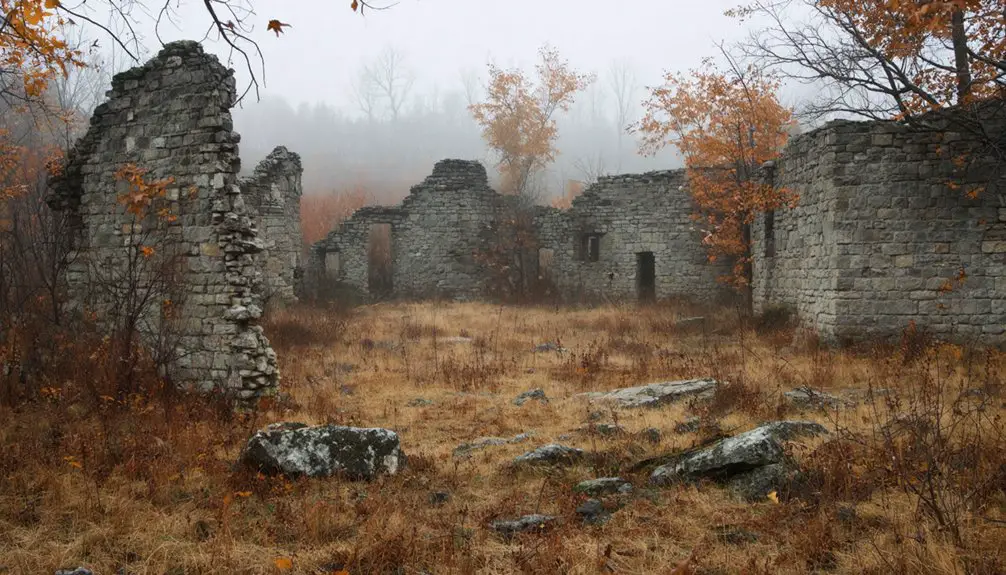
Located in Marathon County’s Eau Pleine town, Staadts occupied a strategic position in central Wisconsin, approximately 2.5 miles southwest of Stratford.
The geographical features of the area included rolling hills and mixed woodlands, typical of central Wisconsin’s natural habitats.
The region’s abundant resources shaped Staadts’ development and potential economic activities:
- Dense forests provided valuable timber for harvesting and building materials
- Local waterways supported logging operations and transportation needs
- Soil composition allowed for small-scale farming alongside forestry
You’ll find the area positioned near essential water sources within the Eau Pleine watershed, making it historically attractive for settlement.
The town’s location at coordinates 44.77917°N, 90.12000°W placed it within reach of regional trade routes and transportation networks, enhancing its resource accessibility.
Architectural Legacy and Remaining Structures
The architectural remnants of Staadts stand as silent witnesses to central Wisconsin’s rural past. You’ll find evidence of the town’s agricultural heritage in the crumbling concrete stave silos and stone wells that dot the landscape.
The architectural decay is most visible in the collapsed wooden structures, where roofless frames and weathered foundations tell stories of abandoned homesteads.
Like many Wisconsin ghost towns, Staadts’ remaining structures showcase typical 19th and early 20th-century rural construction methods, using locally sourced timber and stone.
While you won’t find preserved buildings like those in Pendarvis, the ruins offer valuable insights into the region’s farming community layout.
These deteriorating remnants, though hazardous to explore, serve as important markers of Wisconsin’s rural heritage and the economic shifts that led to the town’s abandonment.
Historical Documentation and Records
Historical records place Staadts at coordinates 44°46′45″N 90°07′12″W within Marathon County‘s Eau Pleine township, roughly 2.5 miles southwest of Stratford.
Staadts, a forgotten settlement in Marathon County’s Eau Pleine township, lies silent 2.5 miles southwest of modern-day Stratford.
You’ll find extensive documentation through the Wisconsin Historical Society‘s archival research collections, which have preserved the town’s existence through various mapping efforts until at least 1953.
- Marathon County’s government records track the area’s development through land records dating back to 1850.
- Local essential statistics, including births, marriages, and deaths, begin in 1900.
- Newspaper archives and court records from the era provide additional context for historical preservation efforts.
The town’s presence in USGS maps and ghost town catalogs continues to serve genealogical researchers and historians studying the pattern of settlement and abandonment in northern Wisconsin’s former logging and mineral communities.
Impact on Wisconsin’s Mining Region
During Wisconsin’s lead mining boom between 1832 and 1845, Staadts emerged as an essential settlement within the state’s burgeoning mineral extraction region, drawing nearly 10,000 immigrant miners annually.
The town’s cultural influences stemmed from Cornish, Welsh, Irish, and German settlers who brought their mining expertise and community traditions to the area.
Economic factors drove both Staadts’ rise and eventual decline. While rich lead and zinc deposits initially fueled local commerce and sparked infrastructure development, including crucial transportation routes and commercial services, the town’s prosperity wouldn’t last.
When ore deposits were exhausted and competition increased from other regions, Staadts faced abandonment. The railroad’s decision to bypass the town further isolated the community, accelerating its transformation into one of Wisconsin’s notable ghost towns by the early 20th century.
Frequently Asked Questions
Were There Any Major Accidents or Disasters in Staadts’ Mining Operations?
While you’ll find typical mining accidents and operational hazards throughout Wisconsin’s mining history, there’s no documented evidence of major disasters specifically occurring in Staadts’ mining operations.
What Happened to the Families Who Lived There After Abandonment?
You’ll find these family legacies scattered throughout central Wisconsin, as community dispersal led families to nearby towns and cities, seeking jobs in agriculture, logging, or emerging urban industries.
Are There Any Known Photographs of Staadts During Its Prime?
Like searching for a needle in a haystack, you won’t find any confirmed historical photographs of the town. No mining artifacts or official images have surfaced in Wisconsin’s archives or collections.
Did Native American Tribes Have Settlements in the Area Before Staadts?
You’ll find rich tribal histories of Native American settlements in this Wisconsin region, including the Menominee’s ancestral territory near Green Bay and later Ojibwe communities adapting to forest and lake resources.
What Tools and Mining Techniques Were Commonly Used in Staadts?
You’d find miners using hand tools like pickaxes before adopting steam-powered drills and air compressors. Their extraction methods evolved from shallow surface mining to deep mining with water pumping systems.
References
- https://lakecountrytribune.com/exploring-the-haunting-echoes-of-wisconsins-ghost-towns/
- https://upnorthnewswi.com/2024/02/21/the-fascinating-stories-behind-7-wisconsin-ghost-towns/
- https://usghostadventures.com/haunted-stories/the-legend-of-doveland-wisconsin-the-vanishing-town/
- https://pbswisconsin.org/news-item/southern-wisconsins-ghost-towns-leave-behind-vital-stories/
- https://en.wikipedia.org/wiki/List_of_ghost_towns_in_Wisconsin
- https://en.wikipedia.org/wiki/History_of_Wisconsin
- https://docs.legis.wisconsin.gov/misc/lrb/blue_book/2017_2018/160_timeline.pdf
- https://www.wisconsinhistory.org/Records/Article/CS3586
- https://www.youtube.com/watch?v=EdLqndhmXuw
- http://kvr.state.wi.us/About-Us/History/Kickapoo-Valley-Reserve/Early-Settlement/
